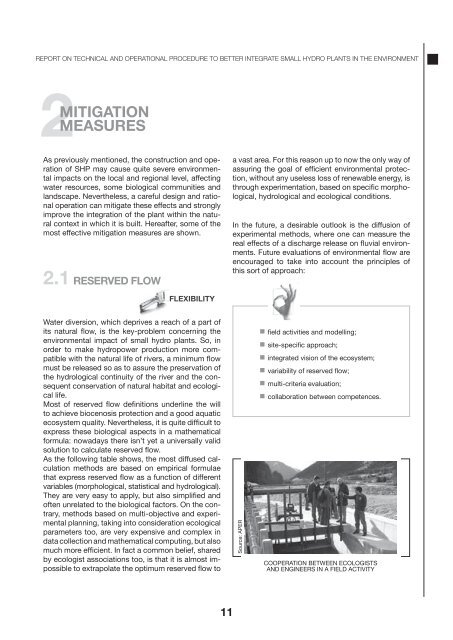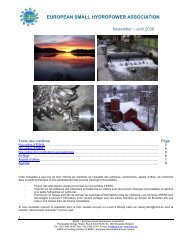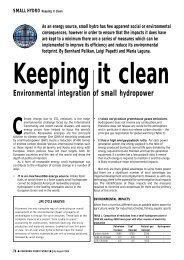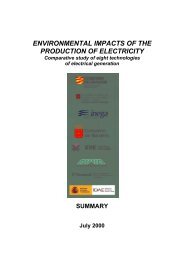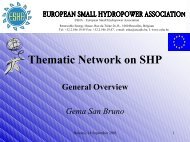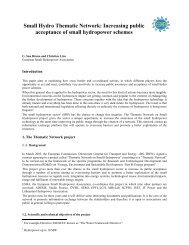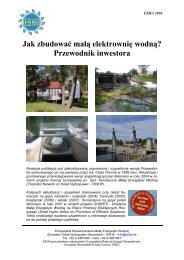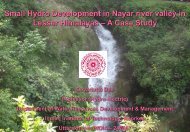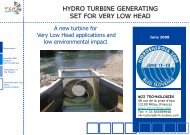HYDROPOWER AND ENVIRONMENT - ESHA
HYDROPOWER AND ENVIRONMENT - ESHA
HYDROPOWER AND ENVIRONMENT - ESHA
You also want an ePaper? Increase the reach of your titles
YUMPU automatically turns print PDFs into web optimized ePapers that Google loves.
REPORT ON TECHNICAL <strong>AND</strong> OPERATIONAL PROCEDURE TO BETTER INTEGRATE SMALL HYDRO PLANTS IN THE <strong>ENVIRONMENT</strong><br />
2MITIGATION<br />
MEASURES<br />
As previously mentioned, the construction and operation<br />
of SHP may cause quite severe environmental<br />
impacts on the local and regional level, affecting<br />
water resources, some biological communities and<br />
landscape. Nevertheless, a careful design and rational<br />
operation can mitigate these effects and strongly<br />
improve the integration of the plant within the natural<br />
context in which it is built. Hereafter, some of the<br />
most effective mitigation measures are shown.<br />
2.1<br />
RESERVED FLOW<br />
FLEXIBILITY<br />
Water diversion, which deprives a reach of a part of<br />
its natural fl ow, is the key-problem concerning the<br />
environmental impact of small hydro plants. So, in<br />
order to make hydropower production more compatible<br />
with the natural life of rivers, a minimum fl ow<br />
must be released so as to assure the preservation of<br />
the hydrological continuity of the river and the consequent<br />
conservation of natural habitat and ecological<br />
life.<br />
Most of reserved fl ow defi nitions underline the will<br />
to achieve biocenosis protection and a good aquatic<br />
ecosystem quality. Nevertheless, it is quite diffi cult to<br />
express these biological aspects in a mathematical<br />
formula: nowadays there isn’t yet a universally valid<br />
solution to calculate reserved fl ow.<br />
As the following table shows, the most diffused calculation<br />
methods are based on empirical formulae<br />
that express reserved fl ow as a function of different<br />
variables (morphological, statistical and hydrological).<br />
They are very easy to apply, but also simplifi ed and<br />
often unrelated to the biological factors. On the contrary,<br />
methods based on multi-objective and experimental<br />
planning, taking into consideration ecological<br />
parameters too, are very expensive and complex in<br />
data collection and mathematical computing, but also<br />
much more effi cient. In fact a common belief, shared<br />
by ecologist associations too, is that it is almost impossible<br />
to extrapolate the optimum reserved fl ow to<br />
11<br />
a vast area. For this reason up to now the only way of<br />
assuring the goal of effi cient environmental protection,<br />
without any useless loss of renewable energy, is<br />
through experimentation, based on specifi c morphological,<br />
hydrological and ecological conditions.<br />
In the future, a desirable outlook is the diffusion of<br />
experimental methods, where one can measure the<br />
real effects of a discharge release on fl uvial environments.<br />
Future evaluations of environmental fl ow are<br />
encouraged to take into account the principles of<br />
this sort of approach:<br />
Source: APER<br />
fi eld activities and modelling;<br />
site-specifi c approach;<br />
integrated vision of the ecosystem;<br />
variability of reserved fl ow;<br />
multi-criteria evaluation;<br />
collaboration between competences.<br />
COOPERATION BETWEEN ECOLOGISTS<br />
<strong>AND</strong> ENGINEERS IN A FIELD ACTIVITY


